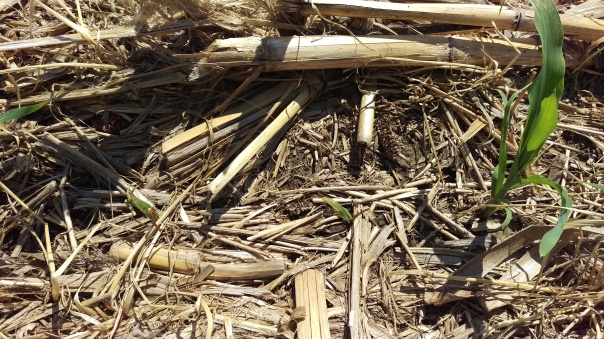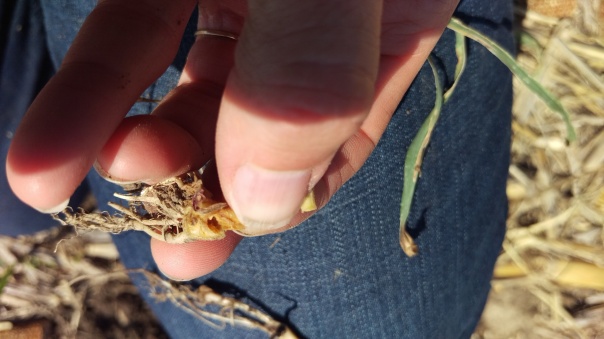Corn Concern in Wheat/Rye Cover

What we see is larger plants next to stunted or shorter plants. The smaller plants often show some type of ‘flagging’ of the leaves where one or several leaves or sometimes the whorl is brown and wilted. Upon digging these plants, the roots were healthy and there were no symptoms of damping off or other obvious disease issues. While there have been reports of some wireworms, this also hasn’t been the main issue with these plants I’ve been seeing.

John Mick with Pioneer alerted me to what he was seeing and several of us have since found the same. Carefully unrolling leaves from the stems of these plants revealed feeding on the stems and crown area. You can see from this photo the small larva of what we believe to be wheat stem maggots (top leaf). I’m finding from 1-3 per plant (on this plant there were more in the disfigured area of the stem). I’m also noticing some plants that are tillering such as is shown in this photo after they’ve been damaged.

The larva in another plant.

The growing point area of the same plant.

Carefully unroll the leaves to reveal any potential larvae.

Also found wheat stem maggot in some rye stems from rye that didn’t completely die. White heads in wheat and rye can be an indication of their feeding. You can then pull on the head and easy removal reveals where the maggot was feeding.
So two questions:
- Why are we seeing this this year?
- Is there anything we need to do?
The short answer to both is that we really don’t know. Perhaps one hypothesis is our warm winter allowed for an earlier generation of wheat stem maggots to pupate and emerge as flies during corn planting when they would typically do so later in May. Perhaps in fields where wheat or rye wasn’t yet terminated, the flies could lay eggs and the larvae that hatched moved from the wheat or rye to the corn upon emergence and once the cover was terminated.
The larvae we’re finding now are in different stages and some are getting close to pupating. After pupating, they will emerge into flies that will lay eggs in grass crops. We don’t know for certain if the flies will lay eggs in these corn fields again or if they will move to other grassy species. We’re not recommending insecticide applications.
South Dakota State and Kansas State have previously reported rare incidences of this occurring in corn. This is my first time observing this in Nebraska. To date, I’ve seen stand loss range in fields from 5-50%.
This doesn’t mean that all potential stunted plants or stand concerns are due to this particular insect as a number of other factors could be involved. This post is intended to increase awareness of another option to look for with the number of questions I’m receiving right now regarding corn concerns in terminated rye or wheat cover.
Dr.s Justin McMechan and Bob Wright are surveying fields and conducting studies to better understand any potential concerns in future years. We will keep you informed as we continue to learn more.
Posted on June 5, 2017, in Crop Updates and tagged corn, rye cover crop, wheat cover crop, wheat stem maggot, wheat stem maggot in corn. Bookmark the permalink. 1 Comment.

Pingback: Cover Crop Commentary: Addressing the Risks of Corn After Rye | Stutsmans